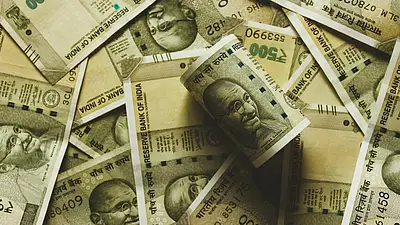On Thursday, the Indian rupee fell to an unprecedented low of Rs 84.30 against the US dollar, marking another setback in a series of depreciations. Initially opening at Rs 84.26—2 paise stronger than Wednesday’s close at Rs 84.28—the rupee soon weakened, reflecting mounting concerns over global economic shifts and a stronger dollar. Bloomberg data confirmed this continued downward trend, as the rupee’s value dipped amid rising demand for the US dollar in global markets.
Trump’s Victory and Its Impact on Currency Markets
The recent surge in the dollar index has been fueled by anticipation around the policies of former US President Donald Trump, who won a significant victory that is expected to influence US monetary and trade policies. Market analysts believe Trump’s return to political prominence may prompt higher US interest rates, aggressive economic policies, and potential tariff impositions, all of which could sustain the dollar’s strength.

The ripple effects of these expectations are evident across Asian markets. Analysts speculate that Trump’s policies could increase the demand for the dollar and put pressure on various Asian currencies, including the Indian rupee, which has already felt the impact. Trump’s proposed economic agenda, including tax cuts without a corresponding reduction in government spending, may support the dollar in the short term. However, this could also lead to rising US debt, which might erode investor confidence in the dollar over time.
Rupee’s Struggle Amid Broader Asian Currency Weakness
The rupee’s recent drop is part of a broader trend affecting Asian currencies, many of which have experienced a decline as uncertainty around the US political landscape grows. The dollar index, which measures the dollar’s performance against a basket of six major currencies, hit 104.98 during Asian trading hours, a sign of the dollar’s ongoing strength and its impact on other global currencies.
In addition to the Indian rupee, other Asian currencies such as the Japanese yen and Malaysian ringgit faced significant depreciation. The Japanese yen dropped by 1.2%, marking one of its sharpest declines, while the Malaysian ringgit and the Chinese offshore yuan saw similar trends. Singapore’s dollar and Thailand’s baht also fell by over 1% on Wednesday, underscoring a regional currency slump linked to the stronger US dollar.
Expert Opinions on the Dollar’s Trajectory and Rupee Outlook
Amit Pabari, Managing Director of CR Forex Advisors, commented on the strengthening dollar, noting that the immediate impact of Trump’s policies could bolster the greenback. However, Pabari cautioned that these gains might be short-lived, especially if increased US debt weakens investor sentiment. “Trump’s tax cuts without spending reduction may initially boost the dollar, but rising debt could erode confidence over time,” he said.
Additionally, Pabari pointed to the risk of tariffs and their impact on consumer prices. “Tariffs, particularly on China, could raise consumer prices, disrupt exports, and reduce global demand for the dollar,” he explained. The Federal Reserve’s anticipated rate cuts in 2025 could further diminish the dollar’s yield advantage, potentially contributing to a bearish outlook for the dollar index in the medium term. In the short run, however, the rupee is likely to face continued downward pressure.
The Reserve Bank of India’s Response and Future Projections
The Reserve Bank of India (RBI) has largely refrained from intervening in the rupee’s slide, even as it reached new lows. With foreign portfolio investors (FPIs) continuing to withdraw from Indian equities, the demand for the dollar remains high, putting additional strain on the rupee. Anil Kumar Bhansali, Head of Treasury and Executive Director at Finrex Treasury Advisors LLP, observed that while the RBI initially provided some support, it eventually stepped back due to overwhelming pressure from dollar demand.
Bhansali anticipates further volatility for the rupee, projecting a likely trading range of Rs 84.20-84.40 in the immediate term. He emphasized the significance of global market dynamics, including rising US yields and declines in other Asian currencies, in shaping the rupee’s trajectory. According to Bhansali, “Need to watch what RBI does during the day today, as the demand for dollars remains robust, driven by a strong dollar index and increasing global uncertainties.”
Global Economic Trends and Domestic Factors Influencing the Rupee
The rupee’s decline is not solely driven by international factors; domestic economic trends also play a role. India’s ongoing foreign portfolio investor outflows and other economic variables are adding to the pressure. The RBI’s decision not to intervene aggressively in the currency markets signals a shift in approach, where the central bank appears willing to allow the rupee to find its market level without direct intervention.
With ongoing global uncertainties, especially around the US political climate and economic policies, analysts expect the rupee to remain under pressure in the near term. The fluctuating nature of global financial markets, coupled with Trump’s potential influence on US economic policy, could result in further depreciation of the rupee and similar downward trends for other Asian currencies.
The Broader Economic Impact of a Weakening Rupee
As the rupee weakens, the broader Indian economy may face additional challenges. A weaker rupee could make imports more expensive, potentially increasing inflationary pressures in the domestic market. This situation could be particularly impactful for sectors reliant on imported goods or raw materials, as higher costs might lead to increased prices for consumers.
In addition to influencing inflation, a weaker rupee could also impact India’s trade balance. While a depreciating currency often benefits exporters by making goods cheaper on the global market, the effect on India’s economy could be mixed. The benefits for exporters may be tempered by rising costs for imported inputs and capital goods, which are essential for many industries in India.
A Glimpse into the Future: What’s Next for the Rupee?
While the immediate future of the rupee remains uncertain, most experts agree that its performance will depend on a complex interplay of domestic and international factors. Continued foreign investor outflows, US economic policies, and global currency movements will all play critical roles in determining the rupee’s strength or weakness in the coming months.
For now, Indian market participants are closely monitoring the actions of the RBI, the dollar index’s fluctuations, and US interest rate trends. A potential shift in the US’s fiscal and monetary policies, especially any moves to ease interest rates or reduce trade barriers, could eventually relieve some pressure on the rupee. However, in the short term, as dollar demand continues to grow and the dollar remains strong, the rupee may continue to trade within its current range or even experience further declines.
In summary, the rupee’s current low against the US dollar reflects a combination of global economic shifts, the effects of US political developments, and the broader trend of a stronger dollar. While the short-term outlook remains challenging, the longer-term impact will depend on how global markets adapt to evolving policies and economic conditions. As the rupee navigates this period of volatility, both investors and policymakers in India are keeping a close watch on these developments and their potential economic consequences.


